Last updated: October 4, 2022
Article
Bumble Bees of Alaska: A Field Guide
Introduction to Bees of Alaska
By Jessica Rykken, EntomologistBumble bees are abundant and conspicuous pollinators across most of Alaska. They are well-adapted to cold, harsh climates and live in every habitat where there are fowers offering up pollen and nectar, including forests, shrublands, tundra, wetlands, riparian areas, beaches, and gardens. Some species are generalists, distributed widely across habitats and regions, while others are restricted to particular habitats or known only from certain areas. Bumble bees are pollinators of many Alaskan wildfowers, as well as shrubs like willows, blueberries, and cranberries. Many animals, including humans, rely on these pollinated plants for food, shelter, and medicine. Thus, bumble bees, as well as many other kinds of bees and insect pollinators, are essential members of Alaskan ecosystems.
The details of this natural history guide are laid out below, or you can download a print-friendly version of the bumble bee identification guide.
Using This Guide
The guide covers all 22 bumble bee species known in Alaska. Read the following sections to familiarize yourself with bee anatomy and what to look for when trying to identify a bumble bee. Note that the guide is for female bees only (workers or cuckoo females). Use the distribution information to get an idea of which species are known from the area you’re in. Bees are easiest to identify when they are foraging. Position yourself near an active patch of fowers—blue, pink, or purple are often favored by bumble bees—and spend some time observing. Close-focus binoculars can be helpful. Taking a photo that you can refer to later is also a good way to practice. You can submit photos to online groups like iNaturalist or BugGuide for more help.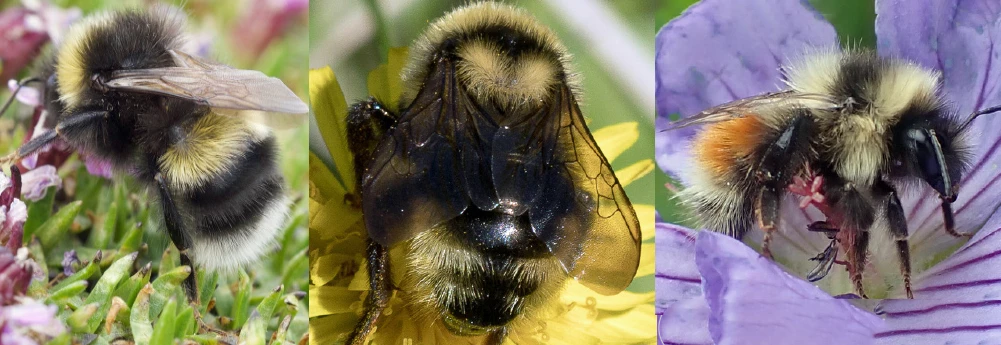
Photo credits from left to right: Scott King; Liz Osborn; Matt Muir
Is It a Bumble Bee? Mimics
There are a surprising number of insects that mimic bumble bees to fool predators into thinking they can sting. Many of these bee impostors also forage at fowers. Here are some common bumble bee look-alikes: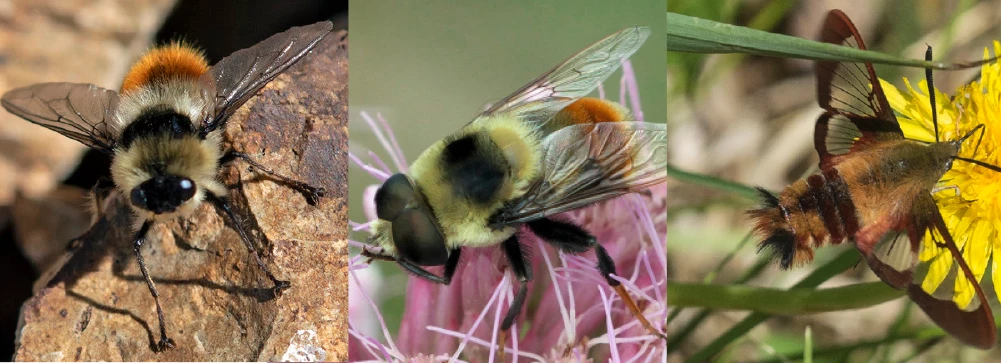
Middle: This orange-legged drone fly (Eristalis flavipes) is another excellent mimic, but note the large eyes, single pair of wings, and tiny bristly antennae that identify it as a fly.
Right: Even moths can mimic bumble bees! The furry body and colored bands of this hummingbird clearwing moth (Thysbe hemaris) can fool a predator.
Photo credits from left to right: John Melkle; Paul Tavares; Robert Brown
Bumble Bee Anatomy
Like most insects, bumble bees have 3 main body sections, 3 pairs of legs, and 2 pairs of wings. Bumble bees are larger than most other bees and much of their body is covered in long, colorful hair. Most female bumble bees have a concave pollen basket on each hind tibia for carrying loads of pollen and nectar back to the nest; these yellow or orange pollen balls are often visible.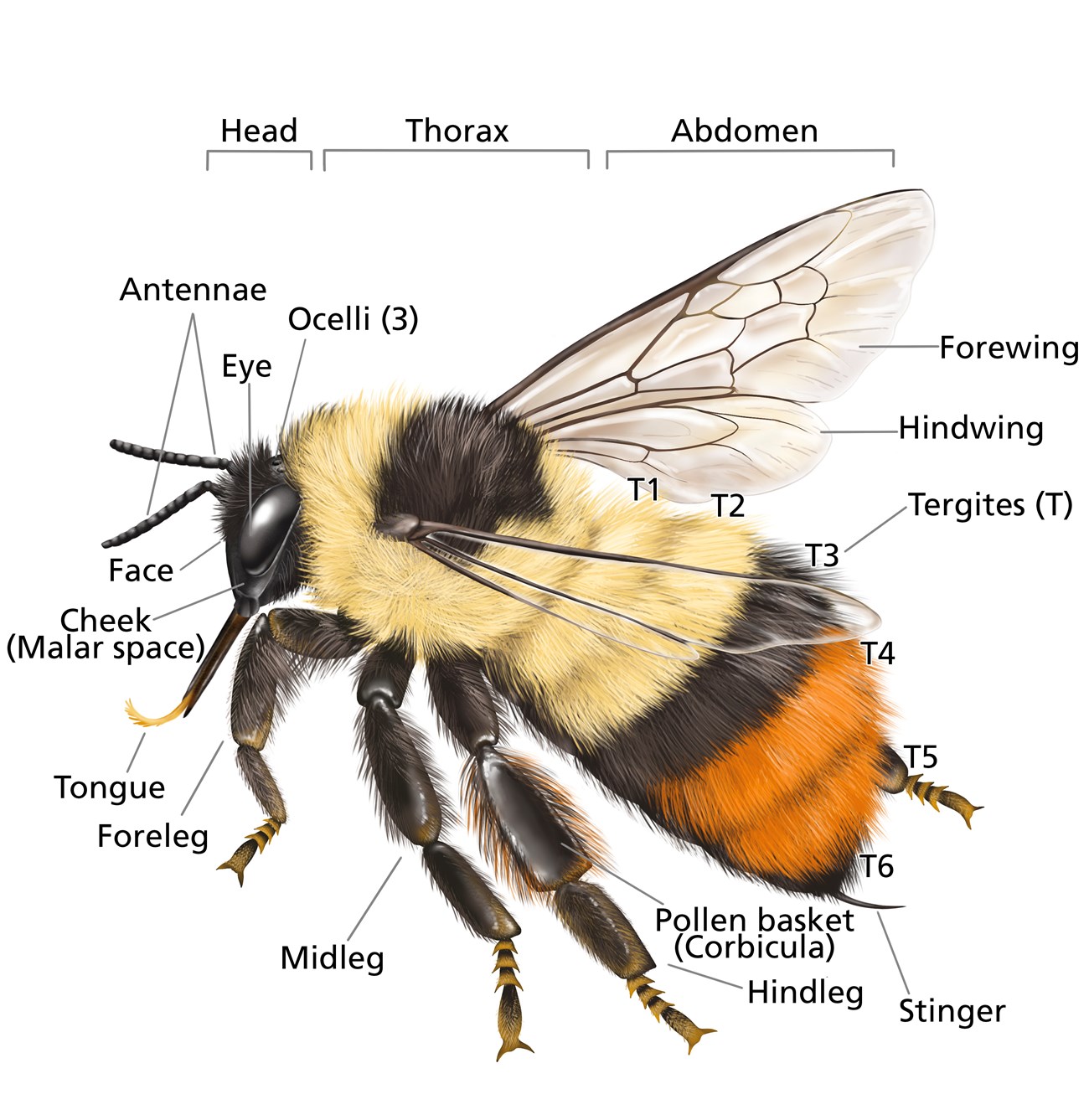
NPS Illustration / Laurel Mundy
Tips for Identifcation
Many bumble bees can be identifed to species based on hair color alone. Check the color on the face, top and sides of thorax, and six abdominal tergites (T1–T6). Some species show a lot of color variation regionally, see notes for each species. Bees may also lose hair as the season goes on, making them look darker. Besides hair color, features like cheek length or the texture of the exoskeleton can be important for identifcation, but these require careful examination under magnifcation.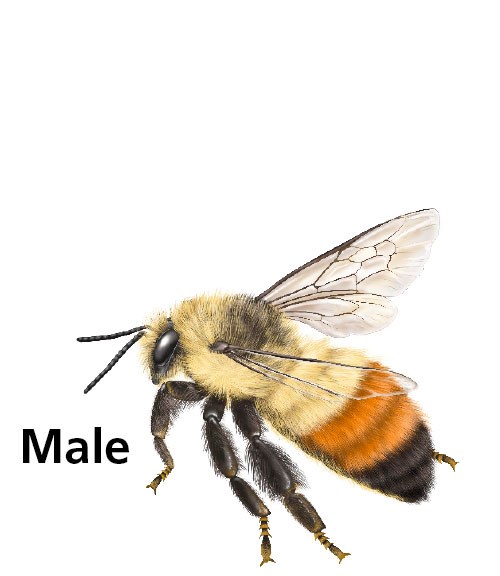
NPS Illustration / Laurel Mundy
Males, Workers, and Queens
The anatomy of male and female bumble bees differs (see below). Males are typically produced later in the season, when new queens also appear. Once males leave the nest they don’t return, and can be found congregating with other males on flowers at night or in bad weather. Queens are generally very similar in appearance to workers (sterile females) but have a larger body size.Male features:
- Longer antennae
- Hairier head
- Hair patch on mandibles
- No pollen baskets
- 7th abdominal segment
- No stinger
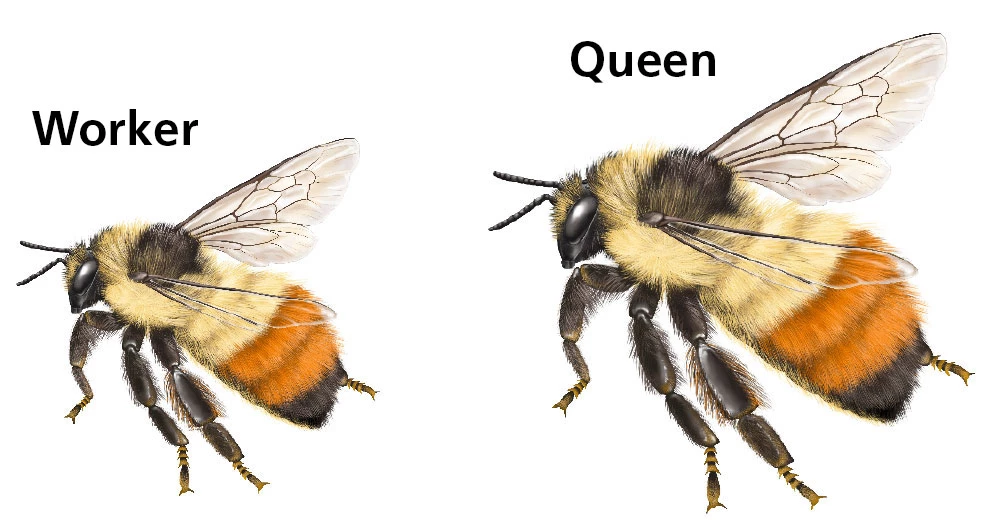
NPS Illustration / Laurel Mundy
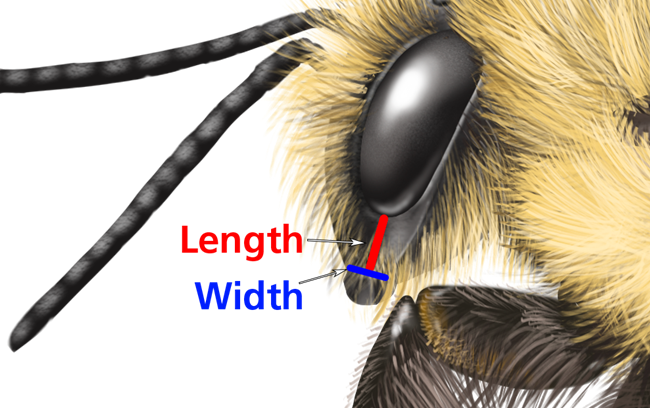
NPS Illustration / Laurel Mundy
Bumble Bee Cheeks
There are several species that can be told apart reliably only by looking at the length of their cheeks. This is the distance from the bottom of the eye to the “hinge” of the mandible.The cheek is hard to see with the naked eye but we have included its length in the species descriptions.
- Short: Length < Width
- Medium: Length = Width
- Long: Length > Width
Bumble Bee Distribution and Status
The table below provides information on the known distribution, habitat associations, and status of each bumble bee species across Alaska. Note that there are still a lot of information gaps, especially in more remote areas of the state, so you may make new discoveries. Ecoregion key is below the distrubition and status table.| Species | Polar (P) | Boreal (B) | Maritime (M) | Habitat | Status |
|---|---|---|---|---|---|
| bohemicus | 1, 3 | 1, 2 | 2 | Shrublands, tundra | Uncommon |
| cryptarum | 1, 2, 3 | 1, 2, 3 | 1, 2 | Boreal forest, shrublands, tundra | Common |
| distinguendus | n/a | 1, 2 | 1 | Boreal forest, tundra | Rare |
| flavidus | 1, 3 | 1, 2 | 1, 2 | Boreal forest, shrublands, tundra | Uncommon |
| flavifrons | 1, 2, 3 | 1, 2 | 1, 2 | Alpine meadows, boreal forest, forest, grassy meadows, shrublands, tundra | Abundant |
| frigidus | 1, 2, 3 | 1, 2, 3 | 1, 2 | Alpine meadows, boreal forest, shrublands, tundra | Abundant |
| insularis | 1, 3 | 1, 2 | 1, 2 | Alpine meadows, boreal forest, shrublands, tundra | Common |
| johanseni | 1, 2 | n/a | 1? 2? | Tundra, possibly others | Status unknown |
| jonellus | 1, 2, 3 | 1, 2 | 1, 2 | Boreal forest, shrublands, tundra | Abundant |
| kirbiellus | 1, 2, 3 | 1, 2 | 1, 2 | Boreal forest, tundra | Uncommon |
| kluanensis | n/a | 2 | n/a | Tundra | Rare |
| lapponicus sylvicola | 1, 2, 3 | 1, 2, 3 | 1, 2 | Alpine meadows, boreal forest, grassy meadows, shrublands, tundra | Abundant |
| mckayi | 1, 3 | 1, 2 | 1, 2 | Alpine meadows, boreal forest, grassy meadows, shrublands, urban gardens | Abundant |
| melanopygus | 1, 2, 3 | 1, 2, 3 | 1, 2 | Alpine meadows, boreal forest, grassy meadows, shrublands, tundra, urban gardens | Abundant |
| mixtus | 1, 2, 3 | 1, 2, 3 | 2 | Alpine meadows, boreal forest, grassy meadows, shrublands, tundra | Abundant |
| natvigi | 1, 2, | 1, 2 | n/a | Tundra | Uncommon |
| neoboreus | 1, 2 | 1, 2 | n/a | Tundra | Uncommon |
| perplexus | 1 | 1, 2 | n/a | Forest, grassy meadows | Uncommon |
| polaris | 1, 2, 3 | 1, 2, 3 | 2 | Tundra | Uncommon |
| rufocinctus | 1 | 1 | 2 | Forest, urban gardens | Rare |
| sitkensis | n/a | 2 | 1, 2 | Forest, grassy meadows | Common |
| vancouverensis | 2 | 1, 2 | 2 | Alpine meadows, shrublands, urban gardens | Common |
Alaska Ecoregion Key
| Polar (P) | Boreal (B) | Maritime (M) |
|---|---|---|
| P1: Arctic tundra | B1: Intermontane boreal | M1: Aleutian mountains |
| P2: Bering tundra | B2: Alaska Range transition | M2: Coastal rainforests |
| P3: Bering taiga | B3: Coast mountains transition |
Alaska Ecoregion Map
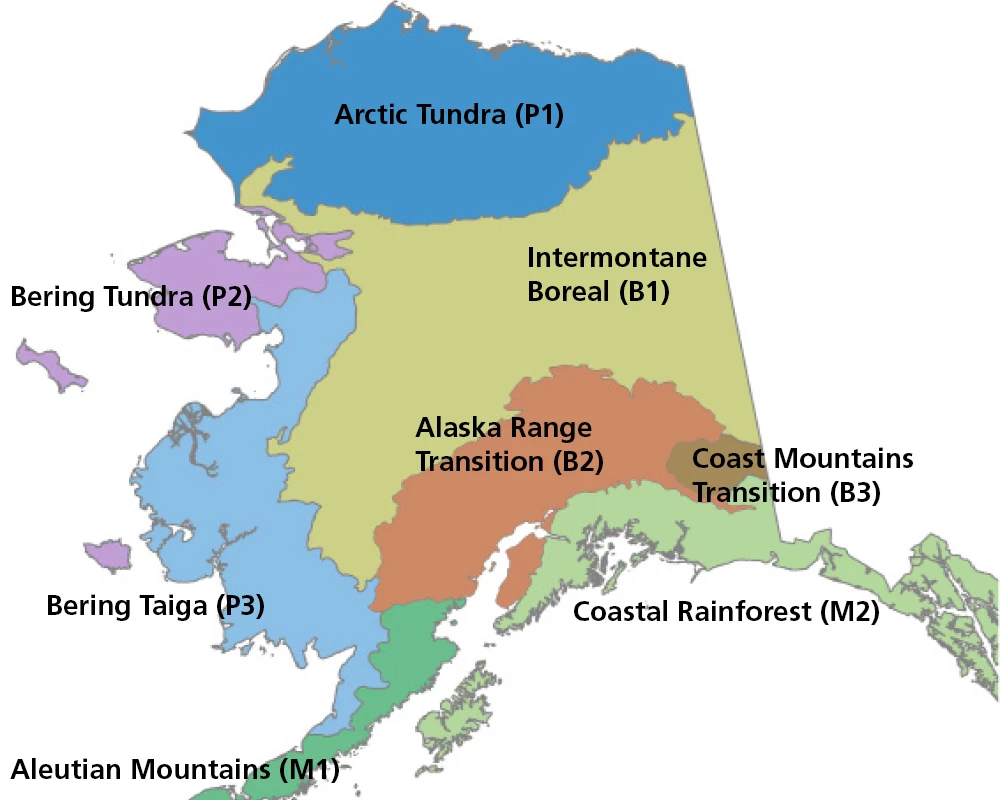
NPS / Marty Byrne
Annual Life Cycle of Bumble Bees
Bumble bees are among the frst insects to be active in the spring, feeding on willows and other early-blooming plants (A, below). These emerging queens have spent the last 7 or more months underground. After building up her energy reserves, the queen will establish a nest in an abandoned burrow or underground cavity and begin to lay eggs (B). She produces her frst brood of workers (sterile females) and they will take over the work of foraging and raising the young (C). Later in the summer, the queen switches to producing males and fertile females (new queens), which will mate with bees from other colonies (D). When colder weather sets in, most of the colony members die. Only the newly-mated queens will overwinter (E).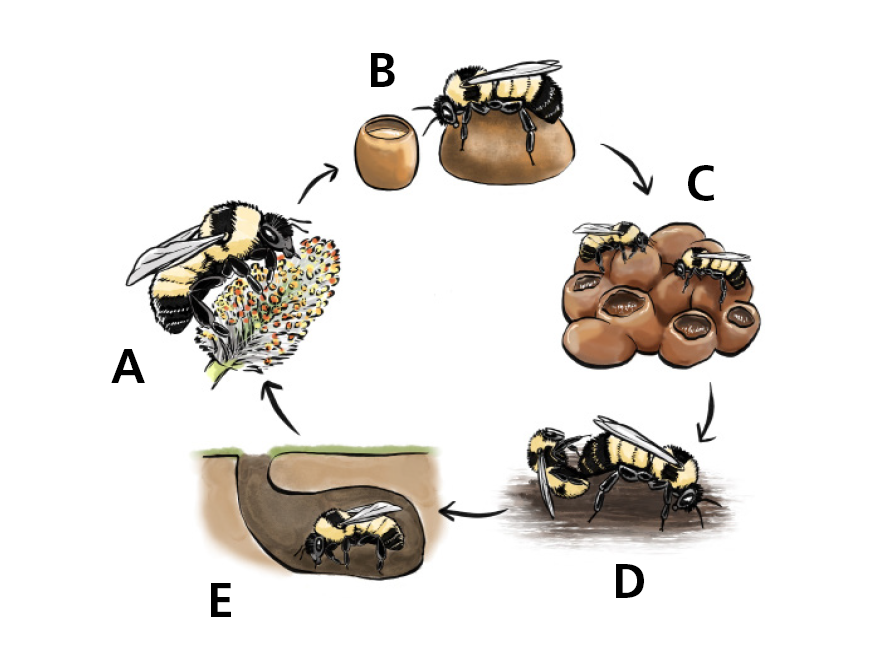
NPS Illustration / Laurel Mundy
Alternative Lifestyles:Cuckoo Bumble Bees
A few bumble bee species in Alaska are parasitic on other bumble bees. A female “cuckoo” bee invades the nest of a social bumble bee, kills the queen and forces the workers to raise her young. Most cuckoo bees are fairly specifc about which species they parasitize. Because they never need to carry pollen, most female cuckoo bumble bees lack pollen baskets on their legs.Conservation Status of Bumble Bees in Alaska
We still have a lot to learn about bumble bees in Alaska: how species are distributed across our vast landscapes and how their populations are faring. Some species of conservation concern in other parts of North America (e.g., the Western bumble bee and its parasite, the Ashton cuckoo bumble bee) appear to be fairly stable in Alaska.Climate change is an accelerating threat for many plants and animals at northern latitudes, and bumble bees living in vulnerable habitats (e.g., tundra) are likely at risk. Inventory, monitoring, and conservation of bumble bee diversity will be essential to preserving the health of our wild and cultivated landscapes. You can help by learning more about bumble bees in places you live and visit.
Tags
- alagnak wild river
- aleutian islands world war ii national historic area
- aniakchak national monument & preserve
- bering land bridge national preserve
- cape krusenstern national monument
- denali national park & preserve
- gates of the arctic national park & preserve
- glacier bay national park & preserve
- katmai national park & preserve
- kenai fjords national park
- kobuk valley national park
- lake clark national park & preserve
- noatak national preserve
- sitka national historical park
- wrangell - st elias national park & preserve
- yukon - charley rivers national preserve
- invertebrate
- pollinator
- bee
- bumble bee
- alaska
